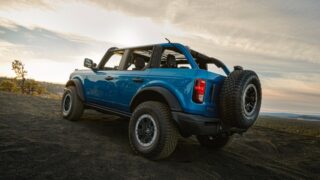2015 Super Duty Engineers Q&A: Part 3

You guys asked a lot of questions last week, but Ford’s Engineers weren’t scared off. In fact, they’ve agreed to come back every week for the next three weeks! You can find them in the forums every Friday until after Memorial Day break. Expect more technically minded responses in the coming weeks. We’ve got questions on piston coatings, weight ratings, powertrain changes, and fuel system contamination below.
Originally Posted by parkland,
Since the ecoboost engine uses performance piston coatings, obviously they work and ford has the ability to implement reliable piston coating technology. Why can’t the 6.7 get coatings on the piston crown, head, exhaust valves, etc so that the increase in power doesn’t come with more wear and tear on the engine? Would this not increase fuel economy, and make the engine more reliable at heavy duty performance, while keeping more heat in the combustion chamber?
And another question,
With the common concern regarding a rare but devastating event of a high pressure fuel pump failure, why not make the entire thing out of steel or ferrous material, so that simple rare earth magnets could be installed as part of the fuel lines or rails, to prevent fuel system contamination in the rare event that the pump fails?
Ford Engineers,
For this one, we reached out to Lem Yeung 6.7L Diesel Engine Design Supervisor.
The reason is because those areas do not require the coating so we would be only adding pass on costs to the customer with no benefit. We find more optimization by running matched/compatible valve and seat materials and localized piston coatings to the skirt only. We run extensive and specific testing to insure our piston and head casting can handle extended time at peak power/cylinder pressures with no structural issues.
There are ferrous materials, stainless steel, and other material types in the design. The HPFP system runs ~30,000psi so materials are chosen primarily for durability and multiple fuel types compatibility. The system is such that microns of metallic particles could cause failures depending on the source so effectiveness of magnets is not feasible/efficient.
Originally Posted by powerstroke72,
A few questions that have been “hot topics” around FTE for years now:
1. Is there any difference between the rear axle in the Single Rear Wheel F-350 Super Duty and the F-250 Super Duty? In the specs in the Ford Body Builder’s Layout booklet for several years, there has been what appears to be a discrepancy which suggests the spline count and axle thickness are different between the two trucks. However, in numerous parts listings, it appears that the two trucks have identical axles. Is this the case in the 2015 Super Duty or are there two different axles used in the F-350 SRW and the F-250?
2. The horsepower and torque ratings are different between the 6.2L gas V8 in the F-250 and the F-350. There have been several conversations here regarding the reasons for the difference in the power ratings for the two. From the specs on the Ford site, it’s clear that the ratings are taken at different RPMs for the trucks with GVWRs higher than 10,000 pounds versus those with a GVWR of 10,000 pounds or less. Could you elaborate as to the reason for this and whether the power ratings for the trucks with a GVWR of greater than 10,000 pounds would be the same if taken at the same RPM as those with 10,000 GVWR and under?
3. In some of the 2011 and 2012 model trucks there were numerous complaints about shift flares in the 1-2 shift, the 2-3 shift, and the 4-5 shift. There were also other issues some owners experienced related to the transmissions and there were flashes, solenoid replacements, etc. authorized as repairs in many cases. Have these issues been resolved with the powertrain updates in the 2015 Super Duty? Thanks in advance and we appreciate your participation on FTE.
Ford Engineers,
1. The axles used for the 2015 F-250 and SRW F-350 are the same.
2. John, we know you’re very interested in this based on some of your previous posts. We have different horsepower and torque ratings for the F-250 and F-350 6.2-liter V8 due to different test procedures used for the different gross vehicle weight ratings of each truck. Engine output for both the F-250 and F-350 is the same, it’s just that the rating is different because of the GVWR. Let us know if you have more questions about this.
3. Thank you! The team regularly reviews customer and field feedback on engine drivability and transmission shift quality. Calibration refinements have been made based on customer feed-back to address shift and engagement feel.
Originally Posted by Y2KW57 ,
This is a powertrain question for Scott Paddy, Alan Costantino, & Greg Gardner:
The 2015 Order Guide for F-450 & F-550 Chassis Cabs indicates the same carryover HP/TQ levels that the previous 2011- 2014 6.7L diesel engine had.
Does this mean that NONE of the 2nd generation improvements announced for the 2015 6.7L diesel in pickups will apply to the Chassis Cabs?
Specifically, does this mean that the 2015 Chassis Cabs will NOT get:
• Best-in-class ratings of 860 lb.-ft. of torque and 440 horsepower
• New, larger turbocharger for greater on-demand performance
• Larger compressor vane for exhaust gases to turn the compressor, permitting lower boost pressure and eliminating the wastegate
• New fuel pump and injectors for more power and reduced emissions
• New temperature control system for enhanced turbo efficiency and performance
Are you still going to build two different types of 6.7L engines in 2015, one for the pickups, and a different one for the Chassis Cabs?
Will the 2015 Chassis Cab diesel engines carryover unchanged from 2014?
Are the alterations made to the 2015 pickup diesel engines planned to be introduced to the Chassis Cab?
Will there be ANY changes to the 2015 chassis cab engine, even if they are not the same changes that have been made to the 2015 pickup engine?
Ford Engineers,
Great question, Y2KW57. We asked Scott and Alan and here’s what they had to say:
The changes that we made for the improved power and torque for the 2015 model year only apply to the pickup truck. For the 2015 model year pickup truck engine, we made changes to the turbo, the high pressure fuel pump and the injectors. We also made changes to the intake system and the controls and in some configurations the axles as well. The chassis cabs we in powertrain call the dyno-cert engines, and we did not change those, so all those ratings stay the same. Even though the pickup and the dyno-cert share the same block, they are certified completely differently. The ratings of the chassis cabs fall into a whole different category based on GVWR. It’s a different engine, different turbo charger, different after-treatment, different exhaust system, different EGR system, different torque converter – same block but different engine altogether. Stay tuned for more information about chassis cabs at a later date.




